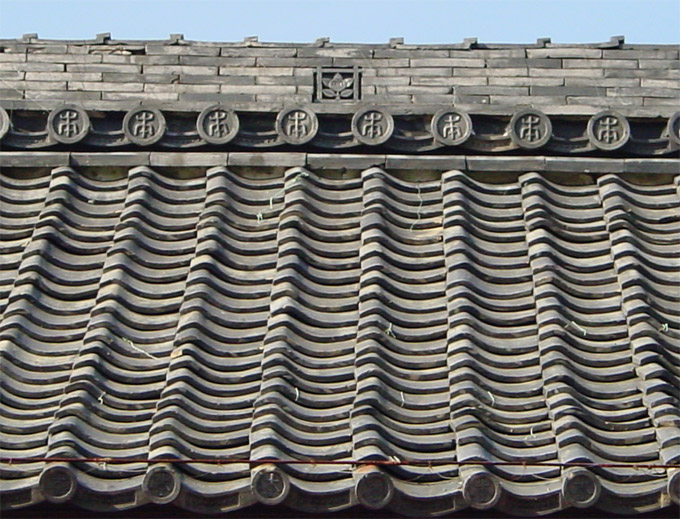|
||
 |
||

Hongakuji
本覚寺 (Kanagawa)
(C)2001 Japanese Architecture and Art Net Users System. No reproduction or republication without written permission.
掲載のテキスト・写真・イラストなど、全てのコンテンツの無断複製・転載を禁じます。
|
||||||
| sangawarabuki 桟瓦葺 | ||||||
| KEY WORD : architecture / roofing tiles | ||||||
| Also called jigawara 地瓦 because it is a base tile; and kanryakugawara 簡略瓦 because it combines a broad concave tile *hiragawara 平瓦 and a semi-cylindrical convex tile *marugawara 丸瓦, into one tile. It is sometimes called kumodomegawara 雲止瓦 (a pantile). The tile is square but undulates from concave to convex. Because it combines two tiles *sangawara 桟瓦 is quicker to produce, lighter weight and easier to lay. In order to distinguish sangawarabuki from the traditional tile roofing composed of separate broad, concave tiles hiragawara, and semi-cylindrical convex tiles marugawara, the term *hongawarabuki 本瓦葺 meaning formal tile roofing was invented. It is believed that Nishimura Gorobee 西村五郎兵衛, (later called Hanbee 半兵衛) first thought to combine the two tiles in 1674. They were originally used on temple roofs and later on residences and other types of buildings. Initially, the part replacing the marugawara, called the san 桟, was large and the concave part replacing the ordinary hiragawara, called the valley *tani 谷 was deep. Gradually, they became uniform and the curves more gentle making them easier to use and to secure. In traditional architecture the sizes of tiles were referred to as shikuban 四九判 (about 49 tiles), gorokuban 五六判 (about 56 tiles), and rokushiban 六四判 (about 64 tiles). The numbers indicate how many tiles were needed to cover a 3.3 sq.m (one tsubo 一坪). Using system, this a tile setter would know immediately how many tiles were needed to cover the entire roof. These tiles usually curve so that the rounded part san is on the right side when facing the tile, but there are cases where the san is reversed and placed on the left side. When they were used for eave-end tiles *nokigawara 軒瓦, the sangawarabuki's san and valley both usually have decorative pendants *gatou 瓦当, circular on the end of the part corresponding to the marugawara and long, curved, concave shaped one corresponding to the hiragawara. Traditionally, arabesque patterns *karakusamon 唐草文 found on the broad concave eave-end tile were applied to the eave-end valley of pantiles, and a comma pattern *tomoemon 巴文 was most frequently used on pendant of the san. If the pendants are undecorated, the combined tile as called manjuu nokigawara 万十軒瓦. | ||||||

Hongakuji
本覚寺 (Kanagawa)
|
||||||
| REFERENCES: | ||||||
| EXTERNAL LINKS: | ||||||
| NOTES: | ||||||
(C)2001 Japanese Architecture and Art Net Users System. No reproduction or republication without written permission. 掲載のテキスト・写真・イラストなど、全てのコンテンツの無断複製・転載を禁じます。 |
||||||